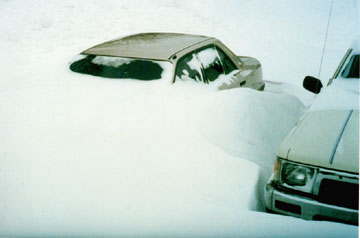Weather Forecasting and Verification
|
|
b = (XT X)-1 XT y
|
Weather Forecasting and Verification is becoming ever more computer intensive. Numerical weather prediction systems become more accurate and detailed with each increase in computer power. Likewise the statistical methods for tailoring their forecasts have progressed from linear regression to include many facets of artificial inelegance. Thus, the role of humans in forecasting is becoming more diverse. Actual forecasters must keep ahead of advancing technology, learning to evaluate the performance of new computer products and combine their guidance to produce the most useful forecasts possible. Numerical model developers must achieve greater understanding of the atmosphere, particularly those processes happening on scales too small to be resolved in their models. And statistical meteorologists must strive to apply the latest techniques in artificial intelligence to extract the maximum information possible from numerical forecasts and forecast verifications.
Forecast Tools | Selected Publications
|
Site |
Region |
Application |
|
United
States |
Thunderstorms
and lake-effect snow |
- B.P. Reen, K.J. Schmehl, G.S.
Young, J.A. Lee, Sue Ellen Haupt and D.R. Stauffer, 2014: Uncertainty in
Contaminant Concentration Fields Resulting from Atmospheric Boundary Layer
Depth Uncertainty. Journal of
Applied Meteorology and Climatology, 53, 2610-2626. --- Abstract
- Greybush, S.J., S.E. Haupt, G.S. Young, 2008: The
regime dependence of optimally weighted ensemble model consensus forecasts
of surface temperature. Weather and Forecasting, 23,
1146-1161. ---
- Hilliker, J.L., G.S. Young, and
J.M. Fritch, 2007: An objective, statistical forecast system for
short-term probabilistic forecasts of thunderstorms. National Weather
Digest, 31, 9-23. --- Abstract
- Young, G.S., 2007: Development of empirical Weather
Forecasting techniques for soaring flight. Technical Soaring, 31,
62-67. --- Abstract
- Schroeder, A.J., D.R. Stauffer, N.L. Seaman, A. Deng,
A.M. Gibbs, G.K. Hunter, and G.S. Young, 2006: An automated
high-resolution, rapidly relocatable meteorological nowcasting and
prediction system. Monthly Weather Review, 134,
1237-1265. --- Abstract
- Watkins, R.R., and G. S. Young, 2006: A synoptic climatology
for those heavy snowfall events spanning the East Coast megalopolis:
Insights from Northeast Snowstorms. National Weather Digest., 30,
45-48. --- Abstract
- Sousounis, P.J., G. Mann, G.S.
Young, B. Hoggatt, W. Bandini, R. Wagenmaker, 2000: Forecasting during the
Lake-ICE/SNOWBANDS Field Experiment. Weather and Forecasting, 14,
955-975. --- Abstract
- Young, G.S., and L. Kristensen,
1992: Boundary layer gusts for aircraft operations. Boundary-Layer
Meteor., 59, 231-242. --- Abstract
- Alexander, G.D., and G.S. Young, 1990: The use of
quantitative surface cyclone characteristics to determine systematic
departures from mean nested grid model forecast errors. National
Weather Digest, 15, 6-12. --- Abstract
- Vislocky, R.L., and G.S. Young,
1989: The use of perfect prog forecasts to
improve model output statistics forecasts of precipitation probability. Weather
and Forecasting, 4, 202-209. --- Abstract
- Vislocky, R.L., and G.S. Young,
1988: Improving your weather forecasts through a better knowledge of skill
scores. National Weather Digest, 13, 15-17. --- Abstract
